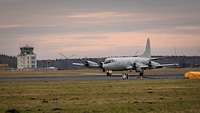
Fleet Commander: “German Navy shows alliance solidarity”
Since 1 February, the Navy has been stepping up activities on NATONorth Atlantic Treaty Organization’s northern flank. A tangible expression of solidarity with allies.


Since the escalation of the Russia-Ukraine conflict, the German Navy has increased its vigilance activities in the Baltic Sea. It is transferring ongoing individual exercises to the region and has adapted the Northern Coasts 2022 fleet exercise.
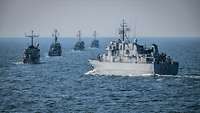
Baltic cooperation: the Lithuanian minelayer “Jotvingis” (right) and the Latvian minesweeper “Talivaldis” (left) in formation with three German vessels during a joint exercise in Riga Bay in March 2022.
Bundeswehr/Florian PersickeVigilance activities are defined by NATONorth Atlantic Treaty Organization as ongoing or normal daily military activities of the Alliance’s forces to ensure adequate strategic situational awareness and the operational readiness of the armed forces. For years, the German Navy for example has been conducting regular reconnaissance flights over the Baltic Sea with P-3C Orion maritime patrol aircraft.
Enhanced Vigilance Activities are measures that are intended to further improve NATONorth Atlantic Treaty Organization’s situational awareness with regard to an emerging change in the security situation. Currently, these are primarily changes in NATONorth Atlantic Treaty Organization’s troop movements and exercises, which have been concentrated on the Alliance’s eastern flank since the beginning of 2022. In view of the ongoing conflict in Ukraine, this is particularly important for NATONorth Atlantic Treaty Organization members in Eastern Europe.
Probably the German Navy’s most important contribution to the Enhanced Vigilance Activities has been the operation Baltic Guard since spring 2022. A work cell in the Maritime Operations Centre (MOCMaritime Operations Centre) in Glücksburg near Flensburg on the border to Denmark is organising to transfer as many national planned exercises as possible from the North Sea to the Baltic Sea. This is to increase the fleet’s presence there.
“There has been a considerable shift of operations of our vessels and aircraft from outside to the Baltic Sea,” confirms Commander Ulrich F. from MOCMaritime Operations Centre. And he adds: “This refers to both national and international naval units. Exact numbers, dates and facts are classified, however.”
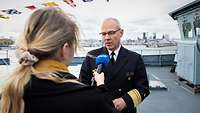
So-called Key Leader Engagement is an integral part of naval diplomacy. Here, Germany’s Chief of Navy Jan Christian Kaack gives interviews to Estonian media on the frigate “Sachsen” in Tallinn harbour in early October – supporting Baltic Guard.
Bundeswehr/Leon RodewaldAt the same time, with Baltic Guard, the Navy offers its partners in the Baltic Sea region to participate in all these exercises. Above all, this means that not only corvettes from Warnemünde and minehunters from Kiel, but now also more frigates from Wilhelmshaven are training their craft directly on NATONorth Atlantic Treaty Organization’s north-eastern flank – together with ships from the Polish or Estonian navies, for example.
“As a large Baltic Sea neighbour, we have a natural focus in the region,” explains Vice Admiral Jan Christian Kaack, Chief of the German Navy. “Our allies expect us to play a leadership role.” The MOCMaritime Operations Centre work cell notices this immediately. “The success of Baltic Guard is reflected in the feedback from the Baltic states and also from other Baltic Sea countries. They rate our commitment very positively,” says Ulrich F.
For the Enhanced Vigilance Activities, the German Navy had made half of its fleet, including submarines, auxiliary and reconnaissance ships, available in the spring – partly even before the outbreak of war between Russia and Ukraine. 28 of them, practically all of them that were not in a shipyard for maintenance, had been assigned to NATONorth Atlantic Treaty Organization formations in February or diverted from individual training operations in the North Sea to the central and eastern Baltic.
“The motto was: everything that floats goes out,” said Vice Admiral Kaack in a recent interview with the German newspaper Welt Online. “Was that sustainable? No. Was it right? Absolutely. Because we showed: Not with us, Mr Putin!” As a result, he said, the Navy had been able to establish “norm behaviour of the Russian fleet with a few exceptions in the aeronautical area”.
However, the Navy still has a structural problem. This was evident in the fact that in spring roughly half of its ships were in a shipyard for maintenance and repair. The theory is that only one-third of the fleet is in maintenance – while another third is always on exercises and a final third is always available for national missions and NATONorth Atlantic Treaty Organization commitments. However, lack of capacity at the Navy Arsenal, the Bundeswehr’s own shipyard, and civilian shipyards has led to a bottleneck. “Up to now, the crews have had to pay for long dockyard layovers, which come at the expense of their training time,” says Kaack.
The purchase of the former civil shipyard MV Werften Rostock by the federal government, in July of this year, will remedy the situation. For the Chief of Navy, this is “a real gamechanger” and he expects it to have the effect of increasing the availability of the fleet from 2023.
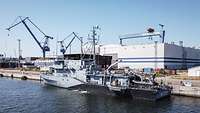
First contact with the “game changer”: minehunter “Fulda” in August at the pier in front of the former civilian MV Werften Rostock. The federal government had announced in June that it would acquire the shipyard as an expansion for the Bundeswehr’s …
BundeswehrMeanwhile, the increased Baltic presence has also affected the Navy’s big annual autumn exercise: Northern Coasts lasted longer than usual this year at four weeks, from 29 August to 28 September. This provided an opportunity for more participation by Germany’s Baltic Sea partners.
The exercise group consisted of the frigate “Schleswig-Holstein”, the submarine “U 32”, the reconnaissance ship “Oste” and the minehunter “Bad Bevensen” as well as shipboard helicopters and maritime patrol aircraft. Their exercise order explicitly states: “The exercise group makes a national contribution within the framework of Enhanced Vigilance Activities and is part of Baltic Guard. Cooperation in training activities with alliance partners is explicitly desired.”
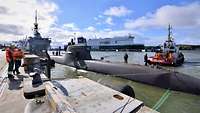
Half-time for Northern Coasts 2022 in Lithuania: Apart from the “Schleswig-Holstein” and the “Bad Bevensen”, submarine “U 32” (front) and intelligence collector “Oste” (rear left) were in Klaipėda harbour for a weekend during an exercise break.
Lithuanian Naval ForcesThe content of Northern Coasts 2022 was first of all the usual training of cooperation between warships of different types and nationalities. In addition, the large-scale exercise in this early autumn had other focal points, including training anti-submarine warfare specifically in the Baltic Sea. The participants also practised creating a multinational, joint and combined, detailed military situation picture of the region and updating it continuously during the manoeuvre.
The main purpose of the increased naval presence in the Baltic Sea is to demonstrate what forces NATONorth Atlantic Treaty Organization is prepared to deploy to keep the sea lanes clear, especially into the Baltic States. Estonia, Latvia and Lithuania, as well as the soon-to-be new NATONorth Atlantic Treaty Organization partner Finland, depend on these links. On the one hand, a very large part of their trade passes over the sea; on the other hand, potential conflict opponent Russia could easily disrupt the land connections from Western Europe to this north-eastern flank of the Alliance. For example, the land bridge between Poland and Lithuania is only 65 kilometres wide, few roads and only one railway line lead north here.
In view of this geostrategic situation, NATONorth Atlantic Treaty Organization’s forward presence on its eastern border is already dependent on the sea route across the Baltic Sea. Since the three battle groups in the Baltic states are expected to grow from battalion to brigade strength in the foreseeable future, supplies by sea are all the more important.
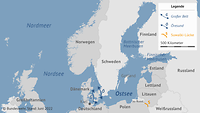
The sea route to the Baltic NATONorth Atlantic Treaty Organization allies leads through the Baltic Sea approaches Öresund and Great Belt (Großer Belt). Because land connections through the Suwalki Gap (Suwalki-Lücke) could be closed in a crisis, the sea area has strategic importance.
Bundeswehr“But because Sweden and Finland are joining NATONorth Atlantic Treaty Organization, we have considerably more options in the region,” Vice Admiral Kaack explains. The navies of the two countries would contribute real maritime special capabilities. These are also important for underwater warfare in relation to the seabed. As in the Atlantic, pipelines and submarine cables run along the Baltic Sea floor. By attacking these critical infrastructures underwater, “it is possible, for example, to quickly cut off Estonia’s electricity,” says Kaack.
Apart from the two connections Nordstream 1 and 2, which have since been shut down and damaged, there are many other underwater connections. For example, the so-called Baltic Pipe, which has only been linking Poland with Denmark’s natural gas supply through Norway since the end of September 2022. The NordBalt high-voltage cable between Sweden and Lithuania has been connecting the electricity grids in Scandinavia and the Baltic States since 2015. Data has been flowing between Germany and Finland in the C-Lion1 submarine cable since 2016.
The fact that the Baltic Sea will largely be a NATONorth Atlantic Treaty Organization body of water following the foreseeable accession of Sweden and Finland will soon enable even closer cooperation between the littoral states to protect this common maritime infrastructure. The German Navy is participating in this with the capabilities of its submarines and mine counter-measure vessels, its combat and clearance divers in particular.
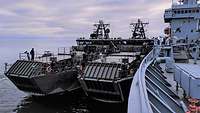
Framework nation Germany: Finland’s foreseeable NATONorth Atlantic Treaty Organization accession raises military cooperation to a new level. Here German tender “Main” with two Finnish Pansio-class minelayers in the Gulf of Finland in March.
Bundeswehr